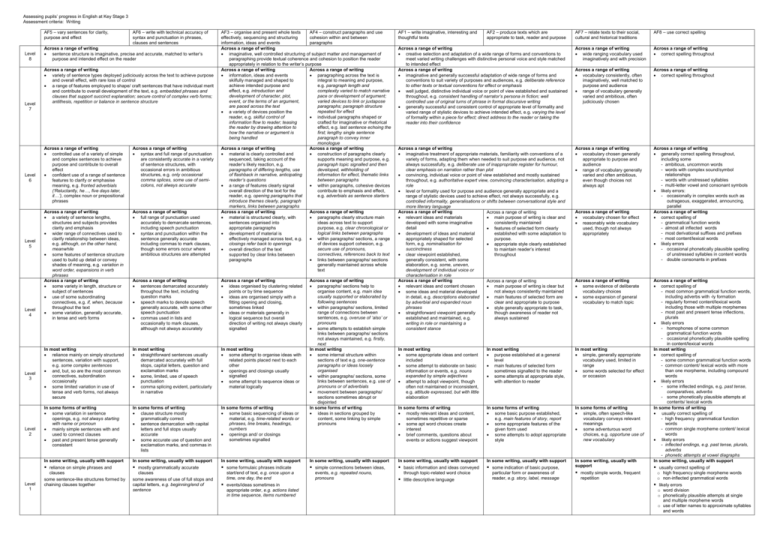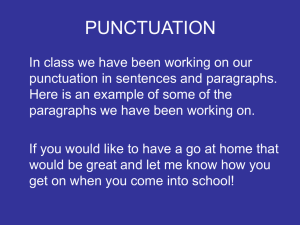Writing assessment guidelines: levels 2 and 3
advertisement

Assessing pupils’ progress in English at Key Stage 3 Assessment criteria: Writing AF5 – vary sentences for clarity, purpose and effect Level 8 Level 7 Level 6 Level 5 Level 4 Level 3 Level 2 Level 1 AF6 – write with technical accuracy of syntax and punctuation in phrases, clauses and sentences Across a range of writing sentence structure is imaginative, precise and accurate, matched to writer’s purpose and intended effect on the reader Across a range of writing variety of sentence types deployed judiciously across the text to achieve purpose and overall effect, with rare loss of control a range of features employed to shape/ craft sentences that have individual merit and contribute to overall development of the text, e.g. embedded phrases and clauses that support succinct explanation; secure control of complex verb forms; antithesis, repetition or balance in sentence structure AF3 – organise and present whole texts AF4 – construct paragraphs and use effectively, sequencing and structuring cohesion within and between information, ideas and events paragraphs Across a range of writing imaginative, well controlled structuring of subject matter and management of paragraphing provide textual coherence and cohesion to position the reader appropriately in relation to the writer’s purpose Across a range of writing Across a range of writing information, ideas and events paragraphing across the text is skilfully managed and shaped to integral to meaning and purpose, achieve intended purpose and e.g. paragraph length and effect, e.g. introduction and complexity varied to match narrative development of character, plot, pace or development of argument; event, or the terms of an argument, varied devices to link or juxtapose are paced across the text paragraphs; paragraph structure repeated for effect a variety of devices position the reader, e.g. skilful control of individual paragraphs shaped or information flow to reader; teasing crafted for imaginative or rhetorical the reader by drawing attention to effect, e.g. last sentence echoing the how the narrative or argument is first; lengthy single sentence being handled paragraph to convey inner monologue Across a range of writing Across a range of writing material is clearly controlled and construction of paragraphs clearly sequenced, taking account of the supports meaning and purpose, e.g. reader’s likely reaction, e.g. paragraph topic signalled and then paragraphs of differing lengths, use developed, withholding of of flashback in narrative, anticipating information for effect, thematic links reader’s questions between paragraphs a range of features clearly signal within paragraphs, cohesive devices overall direction of the text for the contribute to emphasis and effect, reader, e.g. opening paragraphs that e.g. adverbials as sentence starters introduce themes clearly, paragraph markers, links between paragraphs Across a range of writing Across a range of writing material is structured clearly, with paragraphs clearly structure main sentences organised into ideas across text to support appropriate paragraphs purpose, e.g. clear chronological or logical links between paragraphs development of material is effectively managed across text, e.g. within paragraphs/ sections, a range closings refer back to openings of devices support cohesion, e.g. secure use of pronouns, overall direction of the text connectives, references back to text supported by clear links between paragraphs links between paragraphs/ sections generally maintained across whole text AF1 – write imaginative, interesting and thoughtful texts AF2 – produce texts which are appropriate to task, reader and purpose AF7 – relate texts to their social, cultural and historical traditions AF8 – use correct spelling Across a range of writing creative selection and adaptation of a wide range of forms and conventions to meet varied writing challenges with distinctive personal voice and style matched to intended effect Across a range of writing imaginative and generally successful adaptation of wide range of forms and conventions to suit variety of purposes and audiences, e.g. deliberate reference to other texts or textual conventions for effect or emphasis well judged, distinctive individual voice or point of view established and sustained throughout, e.g. consistent handling of narrator’s persona in fiction; well controlled use of original turns of phrase in formal discursive writing generally successful and consistent control of appropriate level of formality and varied range of stylistic devices to achieve intended effect, e.g. varying the level of formality within a piece for effect; direct address to the reader or taking the reader into their confidence Across a range of writing wide ranging vocabulary used imaginatively and with precision Across a range of writing correct spelling throughout Across a range of writing vocabulary consistently, often imaginatively, well matched to purpose and audience range of vocabulary generally varied and ambitious, often judiciously chosen Across a range of writing correct spelling throughout Across a range of writing imaginative treatment of appropriate materials, familiarity with conventions of a variety of forms, adapting them when needed to suit purpose and audience, not always successfully, e.g. deliberate use of inappropriate register for humour, clear emphasis on narration rather than plot convincing, individual voice or point of view established and mostly sustained throughout, e.g. authoritative expert view, convincing characterisation, adopting a role level or formality used for purpose and audience generally appropriate and a range of stylistic devices used to achieve effect, not always successfully, e.g. controlled informality, generalisations or shifts between conversational style and more literary language Across a range of writing Across a range of writing relevant ideas and materials main purpose of writing is clear and developed with some imaginative consistently maintained detail features of selected form clearly established with some adaptation to development of ideas and material appropriately shaped for selected purpose. form, e.g. nominalisation for appropriate style clearly established succinctness to maintain reader’s interest clear viewpoint established, throughout generally consistent, with some elaboration, e.g. some, uneven, development of individual voice or characterisation in role Across a range of writing Across a range of writing relevant ideas and content chosen main purpose of writing is clear but not always consistently maintained some ideas and material developed in detail, e.g. descriptions elaborated main features of selected form are by adverbial and expanded noun clear and appropriate to purpose phrases style generally appropriate to task, straightforward viewpoint generally though awareness of reader not established and maintained, e.g. always sustained writing in role or maintaining a consistent stance Across a range of writing vocabulary chosen generally appropriate to purpose and audience range of vocabulary generally varied and often ambitious, even though choices not always apt Across a range of writing generally correct spelling throughout, including some - ambitious, uncommon words - words with complex sound/symbol relationships - words with unstressed syllables - multi-letter vowel and consonant symbols likely errors: - occasionally in complex words such as outrageous, exaggerated, announcing, parallel Across a range of writing correct spelling of - grammatical function words - almost all inflected words - most derivational suffixes and prefixes - most content/lexical words likely errors - occasional phonetically plausible spelling of unstressed syllables in content words - double consonants in prefixes In most writing some appropriate ideas and content included some attempt to elaborate on basic information or events, e.g. nouns expanded by simple adjectives attempt to adopt viewpoint, though often not maintained or inconsistent, e.g. attitude expressed, but with little elaboration In most writing purpose established at a general level main features of selected form sometimes signalled to the reader some attempts at appropriate style, with attention to reader In most writing simple, generally appropriate vocabulary used, limited in range some words selected for effect or occasion In some forms of writing mostly relevant ideas and content, sometimes repetitive or sparse some apt word choices create interest brief comments, questions about events or actions suggest viewpoint In some forms of writing some basic purpose established, e.g. main features of story, report some appropriate features of the given form used some attempts to adopt appropriate style In some forms of writing simple, often speech-like vocabulary conveys relevant meanings some adventurous word choices, e.g. opportune use of new vocabulary In some writing, usually with support Across a range of writing controlled use of a variety of simple and complex sentences to achieve purpose and contribute to overall effect confident use of a range of sentence features to clarify or emphasise meaning, e.g. fronted adverbials (‘Reluctantly, he…, five days later, it…’), complex noun or prepositional phrases Across a range of writing syntax and full range of punctuation are consistently accurate in a variety of sentence structures, with occasional errors in ambitious structures, e.g. only occasional comma splices, some use of semicolons, not always accurate Across a range of writing a variety of sentence lengths, structures and subjects provides clarity and emphasis wider range of connectives used to clarify relationship between ideas, e.g. although, on the other hand, meanwhile some features of sentence structure used to build up detail or convey shades of meaning, e.g. variation in word order, expansions in verb phrases Across a range of writing some variety in length, structure or subject of sentences use of some subordinating connectives, e.g. if, when, because throughout the text some variation, generally accurate, in tense and verb forms Across a range of writing full range of punctuation used accurately to demarcate sentences, including speech punctuation syntax and punctuation within the sentence generally accurate including commas to mark clauses, though some errors occur where ambitious structures are attempted Across a range of writing sentences demarcated accurately throughout the text, including question marks speech marks to denote speech generally accurate, with some other speech punctuation commas used in lists and occasionally to mark clauses, although not always accurately Across a range of writing ideas organised by clustering related points or by time sequence ideas are organised simply with a fitting opening and closing, sometimes linked ideas or materials generally in logical sequence but overall direction of writing not always clearly signalled In most writing reliance mainly on simply structured sentences, variation with support, e.g. some complex sentences and, but, so are the most common connectives, subordination occasionally some limited variation in use of tense and verb forms, not always secure In most writing straightforward sentences usually demarcated accurately with full stops, capital letters, question and exclamation marks some, limited, use of speech punctuation comma splicing evident, particularly in narrative In most writing some attempt to organise ideas with related points placed next to each other openings and closings usually signalled some attempt to sequence ideas or material logically In some forms of writing some variation in sentence openings, e.g. not always starting with name or pronoun mainly simple sentences with and used to connect clauses past and present tense generally consistent In some forms of writing clause structure mostly grammatically correct sentence demarcation with capital letters and full stops usually accurate some accurate use of question and exclamation marks, and commas in lists In some forms of writing some basic sequencing of ideas or material, e.g. time-related words or phrases, line breaks, headings, numbers openings and/ or closings sometimes signalled In some writing, usually with support In some writing, usually with support In some writing, usually with support In some writing, usually with support In some writing, usually with support In some writing, usually with support reliance on simple phrases and mostly grammatically accurate some formulaic phrases indicate simple connections between ideas, basic information and ideas conveyed some indication of basic purpose, clauses some sentence-like structures formed by chaining clauses together clauses some awareness of use of full stops and capital letters, e.g. beginning/end of sentence start/end of text, e.g. once upon a time, one day, the end events/ideas sometimes in appropriate order, e.g. actions listed in time sequence, items numbered Across a range of writing paragraphs/ sections help to organise content, e.g. main idea usually supported or elaborated by following sentences within paragraphs/ sections, limited range of connections between sentences, e.g. overuse of ‘also’ or pronouns some attempts to establish simple links between paragraphs/ sections not always maintained, e.g. firstly, next In most writing some internal structure within sections of text e.g. one-sentence paragraphs or ideas loosely organised within paragraphs/ sections, some links between sentences, e.g. use of pronouns or of adverbials movement between paragraphs/ sections sometimes abrupt or disjointed In some forms of writing ideas in sections grouped by content, some linking by simple pronouns events, e.g. repeated nouns, pronouns through topic-related word choice little descriptive language particular form or awareness of reader, e.g. story, label, message Across a range of writing vocabulary chosen for effect reasonably wide vocabulary used, though not always appropriately Across a range of writing some evidence of deliberate vocabulary choices some expansion of general vocabulary to match topic mostly simple words, frequent repetition Across a range of writing correct spelling of - most common grammatical function words, including adverbs with -ly formation - regularly formed content/lexical words including those with multiple morphemes - most past and present tense inflections, plurals likely errors - homophones of some common grammatical function words - occasional phonetically plausible spelling in content/lexical words In most writing correct spelling of - some common grammatical function words - common content/ lexical words with more than one morpheme, including compound words likely errors - some inflected endings, e.g. past tense, comparatives, adverbs - some phonetically plausible attempts at contents/ lexical words In some forms of writing usually correct spelling of - high frequency grammatical function words - common single morpheme content/ lexical words likely errors - inflected endings, e.g. past tense, plurals, adverbs - phonetic attempts at vowel diagraphs In some writing, usually with support usually correct spelling of o high frequency single morpheme words o non-inflected grammatical words likely errors o word division o phonetically plausible attempts at single and multiple morpheme words o use of letter names to approximate syllables and words








